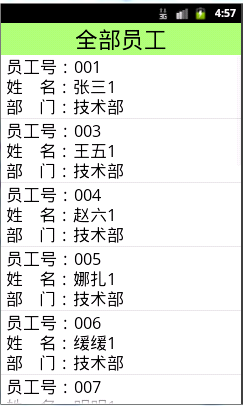編輯:關於android開發
一、概念:
大多數內核子系統都是相互獨立的,因此某個子系統可能對其它子系統產生的事件感興趣。為了滿足這個需求,也即是讓某個子系統在發生某個事件時通知其它的子系統,Linux內核提供了通知鏈的機制。通知鏈表只能夠在內核的子系統之間使用,而不能夠在內核與用戶空間之間進行事件的通知。 通知鏈表是一個函數鏈表,鏈表上的每一個節點都注冊了一個函數。當某個事情發生時,鏈表上所有節點對應的函數就會被執行。所以對於通知鏈表來說有一個通知方與一個接收方。在通知這個事件時所運行的函數由被通知方決定,實際上也即是被通知方注冊了某個函數,在發生某個事件時這些函數就得到執行。其實和系統調用signal的思想差不多。
二、數據結構:
通知鏈有四種類型:
struct atomic_notifier_head
{
spinlock_t lock;
struct notifier_block *head;
};
struct blocking_notifier_head
{
struct rw_semaphore rwsem;
struct notifier_block *head;
};
struct raw_notifier_head
{
struct notifier_block *head;
};
struct srcu_notifier_head
{
struct mutex mutex;
struct srcu_struct srcu;
struct notifier_block *head;
};
通知鏈的核心結構:
struct notifier_block
{
int (*notifier_call)(struct notifier_block *, unsigned long, void *);
struct notifier_block *next;
int priority;
};
其中notifier_call是通知鏈要執行的函數指針,next用來連接其它的通知結構,priority是這個通知的優先級,同一條鏈上的notifier_block{}是按優先級排列的。內核代碼中一般把通知鏈命名為xxx_chain,xxx_nofitier_chain這種形式的變量名。
三、運作機制:
通知鏈的運作機制包括兩個角色:
包括以下過程:
被通知者調用notifier_chain_register函數注冊回調函數,該函數按照優先級將回調函數加入到通知鏈中:
static int notifier_chain_register(struct notifier_block **nl, struct notifier_block *n)
{
while ((*nl) != NULL)
{
if (n->priority > (*nl)->priority)
break;
nl = &((*nl)->next);
}
n->next = *nl;
rcu_assign_pointer(*nl, n);
return 0;
}
注銷回調函數則使用notifier_chain_unregister函數,即將回調函數從通知鏈中刪除:
static int notifier_chain_unregister(struct notifier_block **nl, struct notifier_block *n)
{
while ((*nl) != NULL)
{
if ((*nl) == n)
{
rcu_assign_pointer(*nl, n->next);
return 0;
}
nl = &((*nl)->next);
}
return -ENOENT;
}
通知者調用notifier_call_chain函數通知事件的到達,這個函數會遍歷通知鏈中所有的元素,然後依次調用每一個的回調函數(即完成通知動作):
static int __kprobes notifier_call_chain(struct notifier_block **nl, unsigned long val, void *v, int nr_to_call, int *nr_calls)
{
int ret = NOTIFY_DONE;
struct notifier_block *nb, *next_nb;
nb = rcu_dereference(*nl);
while (nb && nr_to_call)
{
next_nb = rcu_dereference(nb->next);
#ifdef CONFIG_DEBUG_NOTIFIERS
if (unlikely(!func_ptr_is_kernel_text(nb->notifier_call)))
{
WARN(1, "Invalid notifier called!");
nb = next_nb;
continue;
}
#endif
ret = nb->notifier_call(nb, val, v);
if (nr_calls)
(*nr_calls)++;
if ((ret & NOTIFY_STOP_MASK) == NOTIFY_STOP_MASK)
break;
nb = next_nb;
nr_to_call--;
}
return ret;
}
參數nl是通知鏈的頭部,val表示事件類型,v用來指向通知鏈上的函數執行時需要用到的參數,一般不同的通知鏈,參數類型也不一樣,例如當通知一個網卡被注冊時,v就指向net_device結構,nr_to_call表示准備最多通知幾個,-1表示整條鏈都通知,nr_calls非空的話,返回通知了多少個。
每個被執行的notifier_block回調函數的返回值可能取值為以下幾個:
Notifier_call_chain()把最後一個被調用的回調函數的返回值作為它的返回值。
四、舉例應用:
在這裡,寫了一個簡單的通知鏈表的代碼。實際上,整個通知鏈的編寫也就兩個過程:
這裡將第一個過程分成了兩步來寫,第一步是定義了頭節點和一些自定義的注冊函數(針對該頭節點的),第二步則是使用自定義的注冊函數注冊了一些通知鏈節點。分別在代碼buildchain.c與regchain.c中。發送通知信息的代碼為notify.c。
代碼1buildchain.c。它的作用是自定義一個通知鏈表test_chain,然後再自定義兩個函數分別向這個通知鏈中加入或刪除節點,最後再定義一個函數通知這個test_chain鏈:
#include
#include
#include
#include
#include
#include
#include
#include
MODULE_LICENSE("GPL");
/*
* 定義自己的通知鏈頭結點以及注冊和卸載通知鏈的外包函數
*/
/*
* RAW_NOTIFIER_HEAD是定義一個通知鏈的頭部結點,
* 通過這個頭部結點可以找到這個鏈中的其它所有的notifier_block
*/
static RAW_NOTIFIER_HEAD(test_chain);
/*
* 自定義的注冊函數,將notifier_block節點加到剛剛定義的test_chain這個鏈表中來
* raw_notifier_chain_register會調用notifier_chain_register
*/
int register_test_notifier(struct notifier_block *nb)
{
return raw_notifier_chain_register(&test_chain, nb);
}
EXPORT_SYMBOL(register_test_notifier);
int unregister_test_notifier(struct notifier_block *nb)
{
return raw_notifier_chain_unregister(&test_chain, nb);
}
EXPORT_SYMBOL(unregister_test_notifier);
/*
* 自定義的通知鏈表的函數,即通知test_chain指向的鏈表中的所有節點執行相應的函數
*/
int test_notifier_call_chain(unsigned long val, void *v)
{
return raw_notifier_call_chain(&test_chain, val, v);
}
EXPORT_SYMBOL(test_notifier_call_chain);
/*
* init and exit
*/
static int __init init_notifier(void)
{
printk("init_notifier\n");
return 0;
}
static void __exit exit_notifier(void)
{
printk("exit_notifier\n");
}
module_init(init_notifier);
module_exit(exit_notifier);
代碼2regchain.c。該代碼的作用是將test_notifier1test_notifier2test_notifier3這三個節點加到之前定義的test_chain這個通知鏈表上,同時每個節點都注冊了一個函數:
#include
#include
#include
#include
#include
#include
#include
#include
MODULE_LICENSE("GPL");
/*
* 注冊通知鏈
*/
extern int register_test_notifier(struct notifier_block*);
extern int unregister_test_notifier(struct notifier_block*);
static int test_event1(struct notifier_block *this, unsigned long event, void *ptr)
{
printk("In Event 1: Event Number is %d\n", event);
return 0;
}
static int test_event2(struct notifier_block *this, unsigned long event, void *ptr)
{
printk("In Event 2: Event Number is %d\n", event);
return 0;
}
static int test_event3(struct notifier_block *this, unsigned long event, void *ptr)
{
printk("In Event 3: Event Number is %d\n", event);
return 0;
}
/*
* 事件1,該節點執行的函數為test_event1
*/
static struct notifier_block test_notifier1 =
{
.notifier_call = test_event1,
};
/*
* 事件2,該節點執行的函數為test_event1
*/
static struct notifier_block test_notifier2 =
{
.notifier_call = test_event2,
};
/*
* 事件3,該節點執行的函數為test_event1
*/
static struct notifier_block test_notifier3 =
{
.notifier_call = test_event3,
};
/*
* 對這些事件進行注冊
*/
static int __init reg_notifier(void)
{
int err;
printk("Begin to register:\n");
err = register_test_notifier(&test_notifier1);
if (err)
{
printk("register test_notifier1 error\n");
return -1;
}
printk("register test_notifier1 completed\n");
err = register_test_notifier(&test_notifier2);
if (err)
{
printk("register test_notifier2 error\n");
return -1;
}
printk("register test_notifier2 completed\n");
err = register_test_notifier(&test_notifier3);
if (err)
{
printk("register test_notifier3 error\n");
return -1;
}
printk("register test_notifier3 completed\n");
return err;
}
/*
* 卸載剛剛注冊了的通知鏈
*/
static void __exit unreg_notifier(void)
{
printk("Begin to unregister\n");
unregister_test_notifier(&test_notifier1);
unregister_test_notifier(&test_notifier2);
unregister_test_notifier(&test_notifier3);
printk("Unregister finished\n");
}
module_init(reg_notifier);
module_exit(unreg_notifier);
代碼3notify.c。該代碼的作用就是向test_chain通知鏈中發送消息,讓鏈中的函數運行:
#include
#include
#include
#include
#include
#include
#include
#include
MODULE_LICENSE("GPL");
extern int test_notifier_call_chain(unsigned long val, void *v);
/*
* 向通知鏈發送消息以觸發注冊了的函數
*/
static int __init call_notifier(void)
{
int err;
printk("Begin to notify:\n");
/*
* 調用自定義的函數,向test_chain鏈發送消息
*/
printk("==============================\n");
err = test_notifier_call_chain(1, NULL);
printk("==============================\n");
if (err)
printk("notifier_call_chain error\n");
return err;
}
static void __exit uncall_notifier(void)
{
printk("End notify\n");
}
module_init(call_notifier);
module_exit(uncall_notifier);
Makefile文件:
obj-m:=buildchain.o regchain.o notify.o
CURRENT_PATH := $(shell pwd)
LINUX_KERNEL := $(shell uname -r)
KERNELDIR := /usr/src/linux-headers-$(LINUX_KERNEL)
all:
make -C $(KERNELDIR) M=$(CURRENT_PATH) modules
clean:
make -C $(KERNELDIR) M=$(CURRENT_PATH) clean
運行(注意insmod要root權限):
make
insmod buildchain.ko
insmod regchain.ko
insmod notify.ko
這樣就可以看到通知鏈運行的效果了:
init_notifier Android應用開發教程之十三:短信庫解析
Android應用開發教程之十三:短信庫解析
今天我和同學們討論一下Android平台下如何調用系統方法發送短信、接收短信、系統的短信庫相關的問題。進入正題,我們先使用Eclipse工具模擬給自
 Android Studio導入第三方庫(SlidingMenu)教程,androidslidingmenu
Android Studio導入第三方庫(SlidingMenu)教程,androidslidingmenu
Android Studio導入第三方庫(SlidingMenu)教程,androidslidingmenu搞了半天,android的初學者,看著網上各種例子,特此記錄。
 Android(Java)控制GPIO的方法及耗時分析,androidgpio
Android(Java)控制GPIO的方法及耗時分析,androidgpio
Android(Java)控制GPIO的方法及耗時分析,androidgpio 前面兩篇分別介紹了通過腳本和C代碼讀寫/sys/class/gpio以控制GPIO。實際
 Android滑動刪除功能,android滑動刪除
Android滑動刪除功能,android滑動刪除
Android滑動刪除功能,android滑動刪除今天學習了新的功能那就是滑動刪除數據。先看一下效果 我想這個效果大家都很熟悉吧。是不是在qq上看見過這個效果。俗話說好